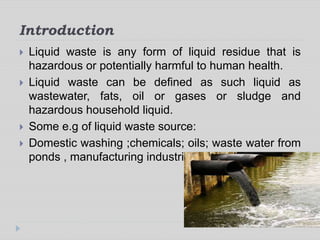The Basic Principles Of Reclaim Waste
Table of ContentsSome Of Reclaim WasteWhat Does Reclaim Waste Do?About Reclaim WasteThe Ultimate Guide To Reclaim WasteReclaim Waste Fundamentals Explained
Explore the types, incidents, and types of liquid waste. Residential sewage waste describes the waste and items from a property sewage-disposal tank. This kind of waste is created by people in homes, institutions, and other buildings. This only includes sewage-disposal tanks that have a drain field. The correct monitoring and disposal of domestic sewage waste need fluid waste to be transferred to a sewage therapy plant where the appropriate methods and equipment are put on cleanse and throw away waste.
Industrial waste typically consists of possible risks, such as combustible products or a mixture of fluid and strong waste items, and requires a more advanced and comprehensive disposal procedure. The disposal of business waste normally entails the filtration of waste before transport to make certain safe and correct disposal. Hazardous waste is developed from by-products and overflow of commercial processes and production.
This type of waste can not make use of the same sewage monitoring transportation or procedures as septic or commercial fluids. The industrial waste monitoring procedure requires the inspection and screening of liquid waste prior to it undergoes the disposal procedure (liquid waste removal). Runoff waste is the liquid waste that originates from drainage and excess stormwater in very inhabited areas or cities
Runoff waste can create contamination and flooding if not dealt with correctly. Making certain proper waste management can protect against disasters and lower ecological injury.
About Reclaim Waste
Contact PROS Solutions today to discover our waste management and disposal solutions and the proper ways to care for the liquid waste you create.
(https://www.provenexpert.com/reclaim-waste/)This supposed 'wastewater' is not only a vital resource yet, after therapy, will be released to our land, waterways or the ocean. Made use of water from bathrooms, showers, baths, cooking area sinks, laundries and commercial procedures is known as wastewater.

water utilized to cool down machinery or clean plant and devices). Stormwater, a type of wastewater, is drainage that moves from agricultural and metropolitan areas such as roofing systems, parks, yards, roadways, courses and seamless gutters into stormwater drains, after rainfall. Stormwater moves neglected straight to neighborhood creeks or rivers, ultimately getting to the sea.
Reclaim Waste Can Be Fun For Anyone
In Queensland, most wastewater is treated at sewage treatment plants. Wastewater is transferred from residential or commercial sites through a system of drains and pump stations, called sewerage reticulation, to a sewer therapy plant. Local governments build, keep and operate most sewage treatment plants. Operators are licensed under the Environmental Management Act 1994 to release treated wastewater at an acceptable ecological requirement right into rivers.
The Department of Natural Resources recommends city governments regarding managing, operating and preserving sewerage systems and treatment plants. In unsewered areas, city governments may need homeowners to install private or family sewage treatment systems to deal with domestic wastewater from commodes, cooking areas, restrooms and washings. The Division of Natural Resources authorizes using family systems when they are proven to be effective.
In some brand-new neighborhoods, treatment of some stormwater to remove trash, sand and gravel has actually started making use of gross toxin traps. Wastewater treatment occurs in 4 stages: Eliminates solid matter.
Makes use of tiny living microorganisms understands as micro-organisms to damage down and get rid of staying dissolved wastes and great bits. Micro-organisms and wastes are included in the sludge.
The Only Guide for Reclaim Waste
Nutrient removal is not readily available at all sewage treatment plants due to the fact that it needs costly specialist equipment. Clear fluid effluent created after treatment may still consist of disease-causing micro-organisms - liquid waste removal.

This generally implies wastewater has to be treated or impurities removed prior to it can be discharged to waterways. Most wastewater moves into the sewage system. Under the Act, local federal governments provide authorizations and licences for eco pertinent activities (Periods) including wastewater launches that could have a neighborhood effect. The division administers authorizations and permits to ERAs entailing wastewater releases that may have a regional or statewide influence.
Some Known Facts About Reclaim Waste.
Otherwise, examples are considered lab analysis. Frequently many tests are required to establish the levels of each of the various toxins such as oils, heavy steels and pesticides in water. Surveillance supplies factual information concerning water top see it here quality and can verify that licence conditions are being met. The details gotten via monitoring gives the basis for making water quality choices.